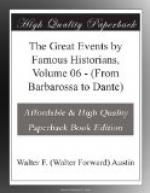Edward pressed on, with characteristic hardihood and resolution. Tower and town fell before him; but his advance was not without such inconvenience and danger as a less determined monarch would have esteemed a good apology for retreat. His army suffered from want of provisions, which were at length supplied in small quantities by some of his ships. As the English King lay at Kirkliston, in West Lothian, a tumult broke out between the Welsh and English in his army, which, after costing some blood, was quelled with difficulty. While Edward hesitated whether to advance or retreat, he learned, through the treachery of two apostate Scottish nobles, the earls of Dunbar and Angus, that Wallace, with the Scottish army, had approached so near as Falkirk.
This advance was doubtless made with the purpose of annoying the expected retreat of the English. Edward, thus apprised that the Scots were in his vicinity, determined to compel them to action. He broke up his camp, and, advancing with caution, slept the next night in the fields along with the soldiers. But the casualties of the campaign were not yet exhausted. His war-horse, which was picketed beside him, like that of an ordinary man-at-arms, struck the King with his foot and hurt him in the side. A tumult arose in the camp, but Edward, regardless of pain, appeased it by mounting his horse, riding through the cantonments, and showing the soldiers that he was in safety.
Next morning, July 22, 1298, the armies met. The Scottish infantry were drawn up on a moor, with a morass in front. They were divided into four phalanxes or dense masses, with lances lowered obliquely over each other, and seeming, says an English historian, like a castle walled with steel. These spearmen were the flower of the army, in whom Wallace chiefly confided. He commanded them in person, and used the brief exhortation, “I have brought you to the ring; dance as you best can.”
The Scottish archers, under the command of Sir John Stewart, brother of the Steward of Scotland, were drawn up in the intervals between the masses of infantry. They were chiefly brought from the wooded district of Selkirk. We hear of no Highland bowmen among them. The cavalry, which amounted to only one thousand men-at-arms, held the rear.
The English cavalry began the action. The Marshal of England led half of the men-at-arms straight upon the Scottish front, but in doing so involved them in the morass. The Bishop of Durham, who commanded the other division of the English cavalry, was wheeling round the morass on the east, and, perceiving this misfortune, became disposed to wait for support. “To mass, Bishop!” said Ralph Basset of Drayton, and charged with the whole body. The Scottish men-at-arms went off without couching their lances; but the infantry stood their ground firmly. In the turmoil that followed, Sir John Stewart fell from his horse and was slain among the archers of Ettrick, who died in defending or avenging him.




